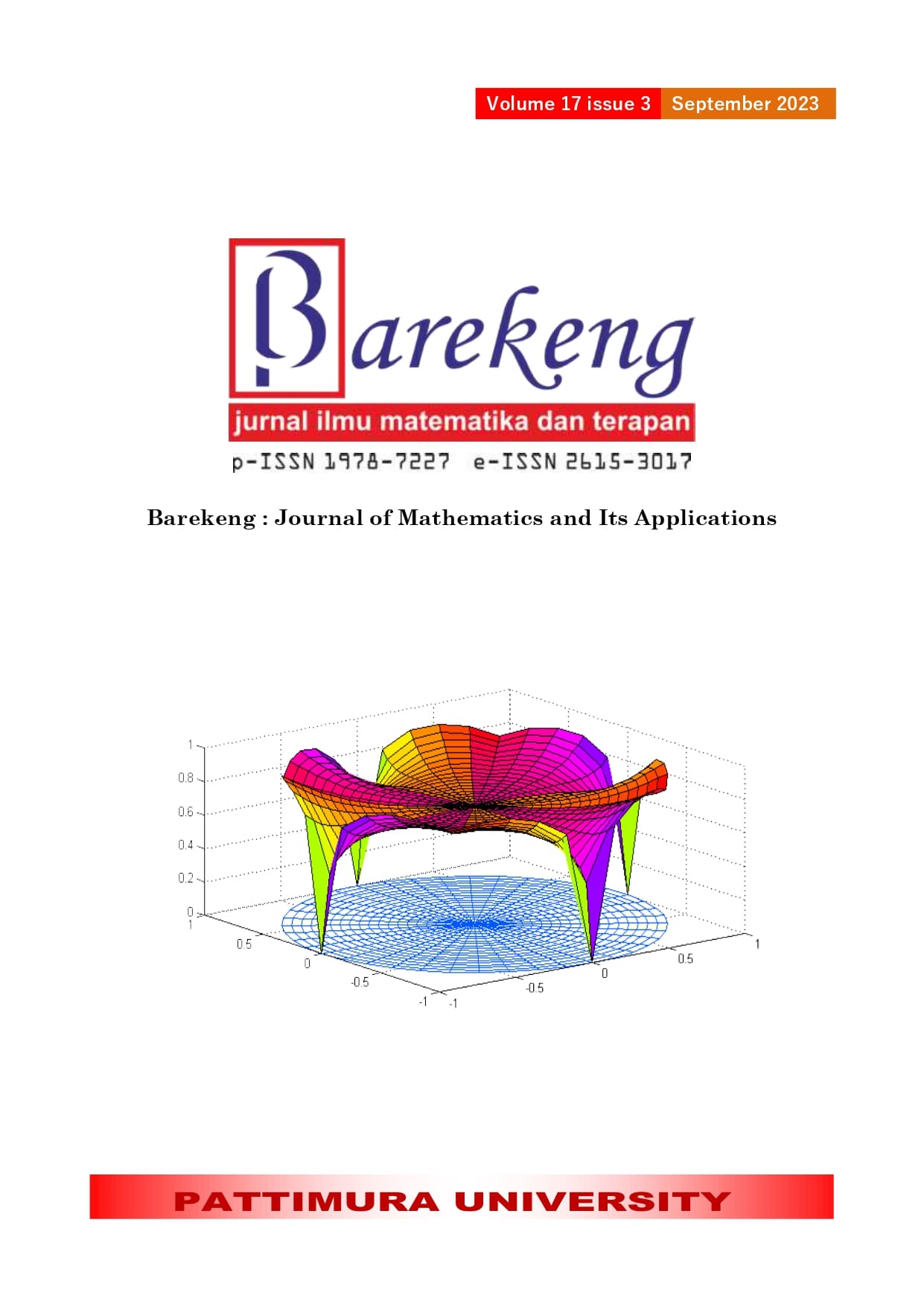MODELLING EARTHQUAKE DISASTER DAMAGE DUE DEPTH OF EPICENTER AND MAGNITUDE USING SPATIAL REGRESSION
Abstract
East Java Province is geographically close to the Eurasian and Indo-Australian Plate subduction zones, resulting in frequent earthquakes East Java Province has a high population density, so it is very risky if disaster occurs. One preventive solution to reduce this impact is estimating damage when an earthquake occurs. The purpose of this study was to determine the best modeling of damages due to earthquakes in East Java Province, using the amount of house damage as a response variable, while depth of the epicenter and the strength of the earthquake as predictor variables. It is suspected that there is a spatial dependency effect in this case, so the solution is to use regression with an area approach, namely the Spatial Durbin Model (SDM). The amount of house damage is collected from BNPB, the epicenter and the magnitude of earthquake collected from BMKG in 2021. The result shows that SDM is good at explaining the dependency relationship between response and predictor variables. The significant predictor variables are the depth of epicenter and the strength of the earthquake. It is meaning that the magnitude and the depth of the epicenter of the earthquake in an area have an impact on other adjacent areas. There is a relationship between the amount of house damage in one area and other adjacent areas. The Regency will have a high number of damaged houses if it is adjacent to a Regency that has a high number of damaged houses
Downloads
References
N. Cholis Madjid, “Analisis Metode Penghitungan dan Alokasi Anggaran Bencana Alam”. Simposium Nasional Keuangan Negara, pp. 1046-1065, 2018.
Tirto, “Mengapa Gempa Dangkal Lebih merusak daripada Gempa Dalam,” 2018. [Online] Diakses: https://tirto.id/mengapa-gempa-dangkal-lebih-merusak-daripada-gempa-dalam-c6mg
Widodo Pawirodikromo, Seismologi Teknik dan Rekayasa Kegempaan. Yogyakarta: Pustaka Pelajar, 2012.
R. P. Plate, Firdaniza, and D. Susanti, “Penentuan Kerugian Tahunan dengan Pemodelan Kebencanaan Alam dan Premi Asuransi Pada Kerusakan Rumah Akibat Banjir,” Jurnal Matematika Integratif, vol. 15, no. 2, pp. 121–128, 2019.
E. A. Ash-Shidiqqi, “Alternatif Strategi Pembiayaan Asuransi Bencana Alam Di Indonesia,” Journal of Governance and Policy Innovation (JGPI) vol. 1, no. 2, pp. 111–119, 2021.
M. V. Rivas-Lopez, R. Minguez-Salido, M. M. Garcia, and A. E. Rey, “Contributions from spatial models to non-life insurance pricing: An empirical application to water damage risk,” Mathematics, vol. 9, no. 19, Oct. 2021.
P. Retnowati, R. Rahmawati, and A. Rusgiyono, “Analisis Faktor-Faktor Perikanan Tangkap Perairan Umum Daratan di Jawa Tengah menggunakan Regresi Berganda dan Model Durbin Spasial,” Jurnal Gaussian, vol. 6, no. 1, pp. 141–150, 2017.
S. E. Triliani and R. Dwi Bekti, “Spatial Durbin Model untuk Mengidentifikasi Faktor-Faktor yang Mempengaruhi Pengangguran di Provinsi Jawa Tengah,” Jurnal Statistika Industri dan Komputasi, vol. 2, no. 2, pp. 93–103, 2017.
H. R. S. Saefulhakim, “Pemodelan spasial penentuan instrumen strategis penataan ruang untuk pengendalian risiko banjir di wilayah Jabodetabek”. Jurnal Ilmu Pertanian Indonesia, Vol 16, no.1, pp 49-58, 2011.
H. Kusumaningrum, D. Endah Kusrini dan, D. Susilaningrum, “Pemodelan spasial ekonometrik kerugian makroekonomi akibat bencana alam”. Tugas Akhir S1 yang tidak dipublikasikan, 2014.
H. Yasin Budi Warsito Arief Rachman Hakim, Regresi Spasial (Aplikasi dengan R). Pekalongan: WADE Publish, 2020.
P. Simoes, I. Natario, M. L. Carvalho, S. Aleixo, and S. Gomes, “Health Line Saude24: An Economic Spatial Analysis of Its Use,” in Geospatial Technology for Human Well-Being and Health, F. S. Faruque, Ed., Swiss: Springer, 2022, pp. 91–118.
A. Arif, M. A. Tiro, and M. Nusrang. “Perbandingan matriks pembobot spasial optimum dalam Spatial Error Model (SEM) kasus: indeks pembangunan manusia kabupaten/kota di Provinsi Sulawesi Selatan Tahun 2015” VARIANSI: Journal of Statistics and Its application on Teaching and Research, vol. 1, no. 2, p. 32, Jul. 2019.
M. Sholikhah, Penggunaan Matriks Pembobot Spasial Tipe Queen Contiguity dan Rook Contiguity pada Regresi Tobit Spasial, Undergraduate [Thesis]. Malang: Universitas Brawijaya, 2014. [Online]. Diakses: UB Repository.
Y. Sari, A. Rizki, and A. H. Wigena, Penggunaan Matriks Queen Contiguity dan K-Nearest Neighbor pada Data Panel Spasial Kemiskinan Sumatera Utara. Undergraduate [Thesis]. Bogor: IPB, 2020. [Online]. Diakses: IPB Repository.
K. Yeni Widiyanti and H. Yasin, “Pemodelan Proporsi Penduduk Miskin Kabupaten dan Kota di Provinsi Jawa Tengah Menggunakan Geographically and Temporally Weighted Regression,” vol. 3, no. 4, pp. 691–700, 2014.
S. Riyanto and A. R. Putera, Metode Riset Penelitian Kesehatan dan Sains. Yogyakarta: Deepublish, 2022.
E. Caroline, Aplikasi Ekonometrika Spasial dengan Software STATA. Surabaya: Scopindo Media Pustaka, 2020.
I. Ghozali, Ekonometrika Teori, Konsep dan Aplikasi dengan SPSS 17. Semarang: Badan Penerbit Universitas Diponegoro, 2009.
J. Osborne, Best Practices in Data Cleaning: A Complete Guide to Everything You Need to Do Before and After Collecting Your Data. SAGE Publications, Inc., 2014.
J. E. De Muth, Basic Statistics and Pharmaceutical Statistical Applications 2nd Edition, 2nd ed. United Kingdom: Taylor & Francis, 2006.
Copyright (c) 2023 Dhea Laksmita Arsya Primananda, Muhammad Muhajir

This work is licensed under a Creative Commons Attribution-ShareAlike 4.0 International License.
Authors who publish with this Journal agree to the following terms:
- Author retain copyright and grant the journal right of first publication with the work simultaneously licensed under a creative commons attribution license that allow others to share the work within an acknowledgement of the work’s authorship and initial publication of this journal.
- Authors are able to enter into separate, additional contractual arrangement for the non-exclusive distribution of the journal’s published version of the work (e.g. acknowledgement of its initial publication in this journal).
- Authors are permitted and encouraged to post their work online (e.g. in institutional repositories or on their websites) prior to and during the submission process, as it can lead to productive exchanges, as well as earlier and greater citation of published works.






1.gif)



